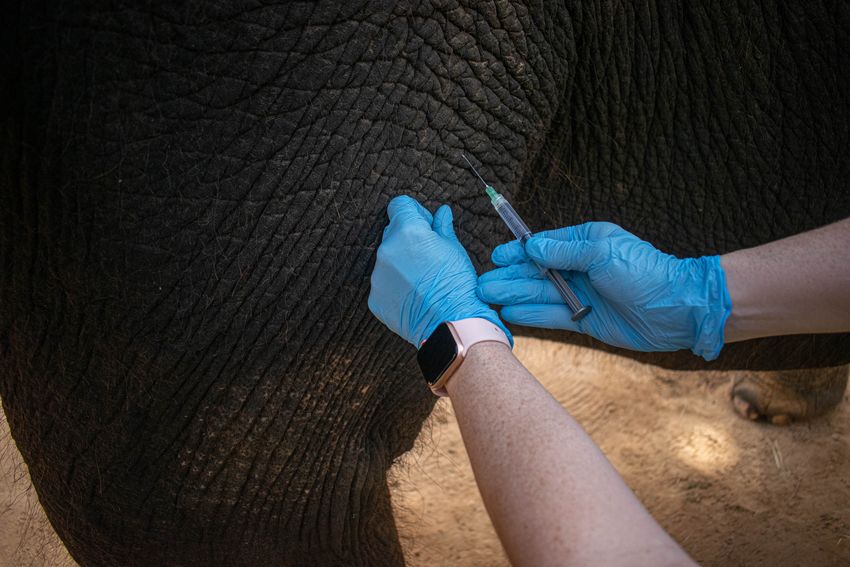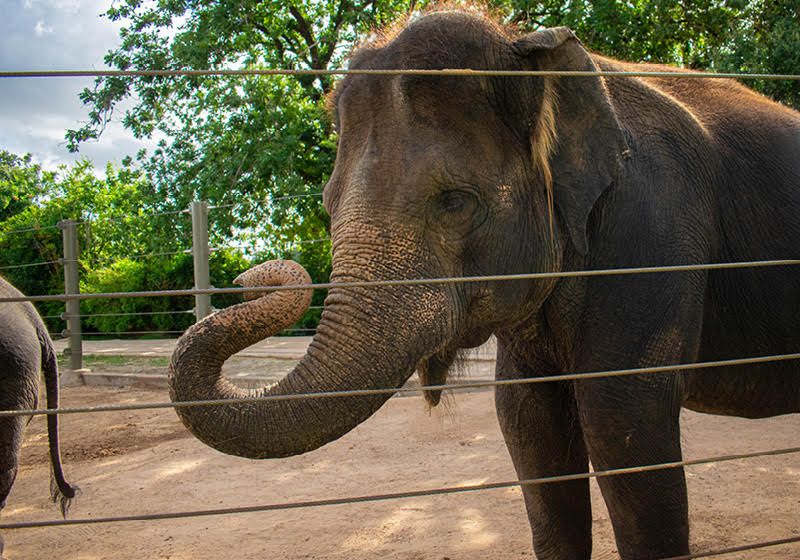Scientists, veterinarians, and zookeepers joined forces to protect elephants from a lethal viral disease. Shown here is Tess, a 40-year-old Asian elephant at the Houston Zoo, who received the first dose of an mRNA vaccine against the virus.
Image credit:Jackelin Reyna, Houston Zoo
In 2008, a two-year-old elephant in the Houston Zoo named Mac suddenly took ill. The usually playful and mischievous elephant toddler became sluggish, lost his appetite, and his head started swelling. He died within a few hours, leaving the zoo staff heartbroken.
Veterinarians soon uncovered the culprit: elephant endotheliotropic herpesvirus (EEHV).1 The virus causes hemorrhagic disease—particularly in young Asian elephants like Mac—and is fatal in almost 70 percent of cases.2 Losing their beloved Mac prompted the zoo staff to approach Paul Dalling Ling, a herpes virologist at the Baylor College of Medicine, to find a solution.
Paul Dalling Ling, a herpes virologist at the Baylor College of Medicine, developed effective diagnostic tools and vaccination for a deadly herpesvirus in elephants.
Baylor College of Medicine
Ling, who worked on human herpesviruses, considered for a couple of days whether he should switch lanes to work on elephant viruses. Ultimately, the urgency of the situation swayed him. “I thought…‘Who wouldn’t want to help save baby elephants?’” said Ling. “And I thought that I had the requisite experience to, maybe, do something about this.”
The ensuing collaboration between Ling and the Houston Zoo led to a “Bench to Barn” research program focused on diagnosing, treating, and developing a vaccine against EEHV. Their work culminated in diagnostic PCR tests—that have now been adopted worldwide for surveillance—to detect EEHV variants that infect elephants.3 The researchers also developed an mRNA vaccine against EEHV that was tested successfully in a 40-year-old elephant, Tess, at the Houston Zoo last year.
Detecting Elephant Endotheliotropic Herpesvirus
While Ling’s long-term goal was to develop a vaccine, he also hoped to improve upon existing PCR-based diagnostic tests and detect EEHV at earlier stages to boost treatment success.4
Early research had revealed that distinct EEHV strains affected Asian and African elephants.5 Ling and his team set out to sequence one of these strains, which proved challenging due to the inability to grow the virus in culture and the lack of an elephant reference genome. Despite this, using next-generation sequencing methods, the researchers assembled the complete EEHV genome.6
As they worked on sequencing the viral genome, Ling and his team built quantitative real-time PCR-based assays to detect several EEHV variants in elephant blood or other fluids like urine, saliva, and trunk secretions.3,7
While elephants do not show signs of disease until very late into the course of the infection, “the qPCR assays showed us that you could actually find [the] virus in the blood several days, or even sometimes a week or two, before clinical signs arose,” said Ling. “This led to developing a monitoring program for elephants [which] is now adopted worldwide.”
An mRNA Vaccine to Protect Elephants Against EEHV
In their quest to generate a vaccine, Ling and his team first developed serological assays to identify the viral proteins that could mount an effective immune response in elephants. Equipped with the candidate vaccine antigens, the researchers focused on finding the best vaccine technology platform.
Lack of in vitro EEHV culture systems ruled out live-attenuated or inactivated vaccine development. The researchers generated subunit vaccines that contained a part of the candidate antigen, but these presented safety and regulatory concerns, steering the team towards an mRNA vaccine.8,9

Researchers, veterinarians, and zookeepers gave the first dose of EEHV mRNA vaccine to Tess, a 40-year-old Asian elephant at the Houston Zoo.
Jackelin Reyna, Houston Zoo
The researchers generated a multiantigen mRNA vaccine against four EEHV antigens that are conserved in all herpesviruses that infect mammals.10 Extensive preclinical testing in mice revealed that the vaccine could induce a robust immune response without adverse side effects.
Encouraged by these results, Ling and his team tested the vaccine in Tess. She did not show any adverse side effects, prompting the team to roll out the jab to a few other elephants across three zoos.
“The elephants so far have responded very well against this vaccine in ways in which we had hoped,” said Ling. Two baby elephants at the Cincinnati Zoo & Botanical Garden—Sanjay and Kabir—who received the vaccine, later tested positive for EEHV. But they recovered from the infection shortly afterwards, indicating that the vaccine was effective.
Looking back, Ling said that carrying out this translational work has been very fulfilling. “Making something that has a real-life, immediate benefit that you can see has been tremendously satisfying,” he said. None of this would have been possible without the collaboration with Houston Zoo and various other zoological parks, he noted. “We know how important it is to address this terrible disease for Asian elephants, and everybody’s really come together as a community to work together to solve this problem.”
- Richman LK, et al. Novel endotheliotropic herpesviruses fatal for Asian and African elephants. Science. 1999;283(5405):1171-1176.
- Boonprasert K, et al. Survival analysis of confirmed elephant endotheliotropic herpes virus cases in Thailand from 2006 – 2018. PLoS One. 2019;14(7):e0219288.
- Stanton JJ, et al. Development and validation of quantitative real-time polymerase chain reaction assays to detect elephant endotheliotropic herpesviruses-2, 3, 4, 5, and 6. J Virol Methods. 2012;186(1-2):73-77.
- Richman LK, et al. Clinical and pathological findings of a newly recognized disease of elephants caused by endotheliotropic herpesviruses. J Wildl Dis. 2000;36(1):1-12.
- Long SY, et al. Review of elephant endotheliotropic herpesviruses and acute hemorrhagic disease. ILAR J. 2016;56(3):283-296.
- Ling PD, et al. Complete genome sequence of elephant endotheliotropic herpesvirus 1A. Genome Announc. 2013;1(2):e0010613.
- Stanton JJ, et al. Detection of pathogenic elephant endotheliotropic herpesvirus in routine trunk washes from healthy adult Asian elephants (Elephas maximus) by use of a real-time quantitative polymerase chain reaction assay. Am J Vet Res. 2010;71(8):925-933.
- Pursell T, et al. Modified vaccinia Ankara expressing EEHV1A glycoprotein B elicits humoral and cell-mediated immune responses in mice. PLoS One. 2022;17(3):e0265424.
- Spencer Clinton JL, et al. The EEHV1A gH/gL complex elicits humoral and cell-mediated immune responses in mice. Vaccine. 2024;42(23):126227.
- Watts JR, et al. Multi-antigen elephant endotheliotropic herpesvirus (EEHV) mRNA vaccine induces humoral and cell-mediated responses in mice. Vaccines. 2024;12(12):1429.

